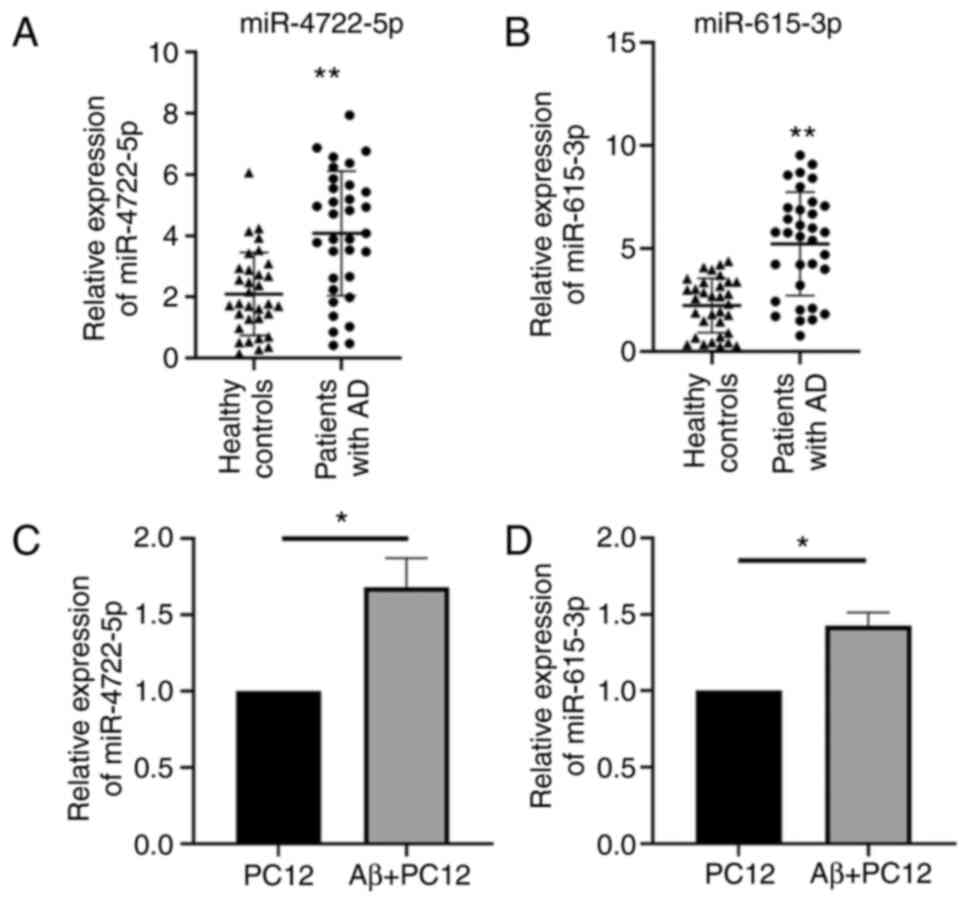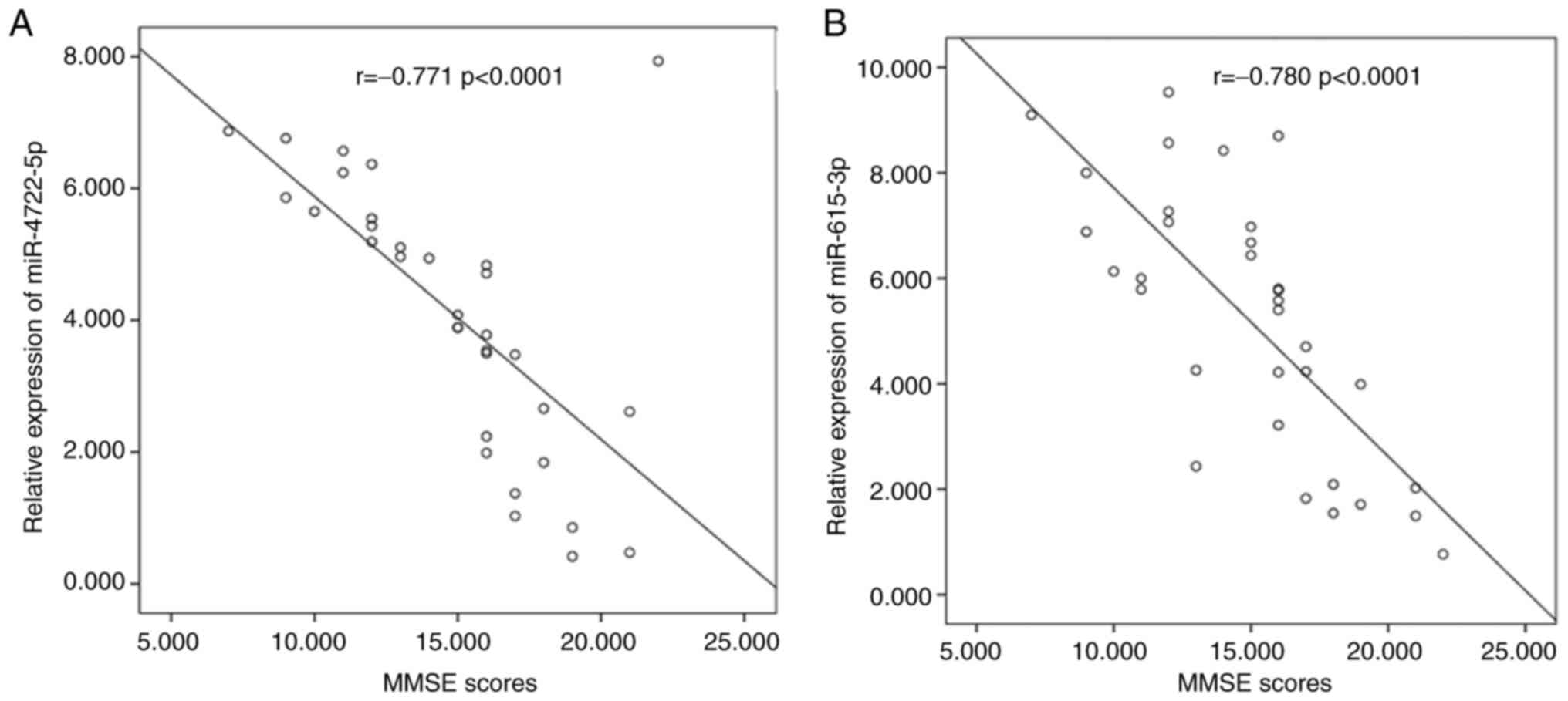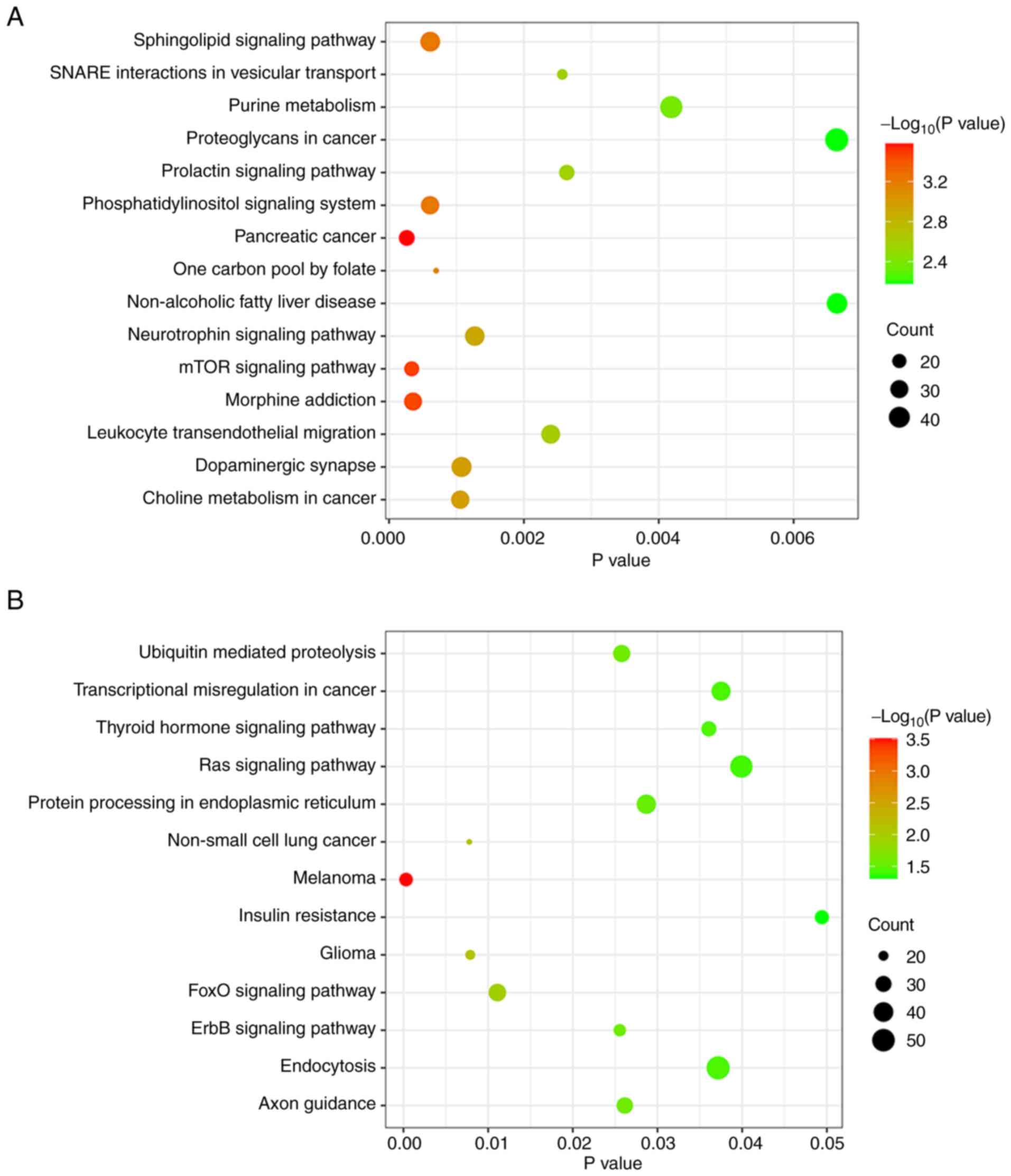|
1
|
Eratne D, Loi SM, Farrand S, Kelso W,
Velakoulis D and Looi JC: Alzheimer's disease: Clinical update on
epidemiology, pathophysiology and diagnosis. Australas Psychiatry.
26:347–357. 2018.PubMed/NCBI View Article : Google Scholar
|
|
2
|
Di Resta C and Ferrari M: New molecular
approaches to Alzheimer's disease. Clin Biochem. 72:81–86.
2019.PubMed/NCBI View Article : Google Scholar
|
|
3
|
Takeda S: Progression of Alzheimer's
disease, tau propagation, and its modifiable risk factors. Neurosci
Res. 141:36–42. 2019.PubMed/NCBI View Article : Google Scholar
|
|
4
|
Jiang L, Dong H, Cao H, Ji X, Luan S and
Liu J: Exosomes in pathogenesis, diagnosis, and treatment of
Alzheimer's Disease. Med Sci Monit. 25:3329–3335. 2019.PubMed/NCBI View Article : Google Scholar
|
|
5
|
Tian X, Wang J, Dai J, Yang L, Zhang L,
Shen S and Huang P: Hyperbaric oxygen and Ginkgo Biloba extract
inhibit Aβ25-35-induced toxicity and oxidative stress in vivo: A
potential role in Alzheimer's disease. Int J Neurosci. 122:563–569.
2012.PubMed/NCBI View Article : Google Scholar
|
|
6
|
Karch CM, Cruchaga C and Goate AM:
Alzheimer's disease genetics: from the bench to the clinic. Neuron.
83:11–26. 2014.PubMed/NCBI View Article : Google Scholar
|
|
7
|
Pereira JB, Westman E and Hansson O:
Association between cerebrospinal fluid and plasma
neurodegeneration biomarkers with brain atrophy in Alzheimer's
disease. Neurobiol Aging. 58:14–29. 2017.PubMed/NCBI View Article : Google Scholar
|
|
8
|
Pradhan R, Yadav SK, Prem NN, Bhagel V,
Pathak M, Shekhar S, Gaikwad S, Dwivedi SN, Bal CS, Dey AB and Dey
S: Serum FOXO3A: A ray of hope for early diagnosis of Alzheimer's
disease. Mech Ageing Dev. 190(111290)2020.PubMed/NCBI View Article : Google Scholar
|
|
9
|
Goetzl EJ, Boxer A, Schwartz JB, Abner EL,
Petersen RC, Miller BL and Kapogiannis D: Altered lysosomal
proteins in neural-derived plasma exosomes in preclinical Alzheimer
disease. Neurology. 85:40–47. 2015.PubMed/NCBI View Article : Google Scholar
|
|
10
|
Abdullah M, Kimura N, Akatsu H, Hashizume
Y, Ferdous T, Tachita T, Iida S, Zou K, Matsubara E and Michikawa
M: Flotillin is a novel diagnostic blood marker of Alzheimer's
Disease. J Alzheimers Dis. 72:1165–1176. 2019.PubMed/NCBI View Article : Google Scholar
|
|
11
|
Briggs R, Kennelly SP and O'Neill D: Drug
treatments in Alzheimer's disease. Clin Med (Lond). 16:247–253.
2016.PubMed/NCBI View Article : Google Scholar
|
|
12
|
Sancesario GM and Bernardini S:
Alzheimer's disease in the omics era. Clin Biochem. 59:9–16.
2018.PubMed/NCBI View Article : Google Scholar
|
|
13
|
Serpente M, Fenoglio C, D'Anca M, Arcaro
M, Sorrentino F, Visconte C, Arighi A, Fumagalli GG, Porretti L,
Cattaneo A, et al: MiRNA profiling in plasma neural-derived small
extracellular vesicles from patients with Alzheimer's Disease.
Cells. 9(1443)2020.PubMed/NCBI View Article : Google Scholar
|
|
14
|
Silvestro S, Bramanti P and Mazzon E: Role
of miRNAs in Alzheimer's Disease and possible fields of
application. Int J Mol Sci. 20(3979)2019.PubMed/NCBI View Article : Google Scholar
|
|
15
|
Yang TT, Liu CG, Gao SC, Zhang Y and Wang
PC: The serum exosome derived MicroRNA-135a, -193b, and -384 Were
potential Alzheimer's Disease Biomarkers. Biomed Environ Sci.
31:87–96. 2018.PubMed/NCBI View Article : Google Scholar
|
|
16
|
Lusardi TA, Phillips JI, Wiedrick JT,
Harrington CA, Lind B, Lapidus JA, Quinn JF and Saugstad JA:
MicroRNAs in human cerebrospinal fluid as biomarkers for
Alzheimer's Disease. J Alzheimers Dis. 55:1223–1233.
2017.PubMed/NCBI View Article : Google Scholar
|
|
17
|
Bai X, Tang Y, Yu M, Wu L, Liu F, Ni J,
Wang Z, Wang J, Fei J, Wang W, et al: Downregulation of blood serum
microRNA 29 family in patients with Parkinson's disease. Sci Rep.
7(5411)2017.PubMed/NCBI View Article : Google Scholar
|
|
18
|
Dobrowolny G, Martone J, Lepore E, Casola
I, Petrucci A, Inghilleri M, Morlando M, Colantoni A, Scicchitano
BM, Calvo A, et al: A longitudinal study defined circulating
microRNAs as reliable biomarkers for disease prognosis and
progression in ALS human patients. Cell Death Discov.
7(4)2021.PubMed/NCBI View Article : Google Scholar
|
|
19
|
Zhang M, Han W, Xu Y, Li D and Xue Q:
Serum miR-128 Serves as a potential diagnostic biomarker for
Alzheimer's Disease. Neuropsychiatr Dis Treat. 17:269–275.
2021.PubMed/NCBI View Article : Google Scholar
|
|
20
|
Shi Z, Zhang K, Zhou H, Jiang L, Xie B,
Wang R, Xia W, Yin Y, Gao Z, Cui D, et al: Increased miR-34c
mediates synaptic deficits by targeting synaptotagmin 1 through
ROS-JNK-p53 pathway in Alzheimer's Disease. Aging Cell.
19(e13125)2020.PubMed/NCBI View Article : Google Scholar
|
|
21
|
Hou TY, Zhou Y, Zhu LS, Wang X, Pang P,
Wang DQ, Liuyang ZY, Man H, Lu Y, Zhu LQ and Liu D: Correcting
abnormalities in miR-124/PTPN1 signaling rescues tau pathology in
Alzheimer's disease. J Neurochem. 154:441–457. 2020.PubMed/NCBI View Article : Google Scholar
|
|
22
|
Han C, Guo L, Yang Y, Guan Q, Shen H,
Sheng Y and Jiao Q: Mechanism of microRNA-22 in regulating
neuroinflammation in Alzheimer's disease. Brain Behav.
10(e01627)2020.PubMed/NCBI View Article : Google Scholar
|
|
23
|
He B, Chen W, Zeng J, Tong W and Zheng P:
MicroRNA-326 decreases tau phosphorylation and neuron apoptosis
through inhibition of the JNK signaling pathway by targeting VAV1
in Alzheimer's disease. J Cell Physiol. 235:480–493.
2020.PubMed/NCBI View Article : Google Scholar
|
|
24
|
Soleimani Zakeri NS, Pashazadeh S and
MotieGhader H: Gene biomarker discovery at different stages of
Alzheimer using gene co-expression network approach. Sci Rep.
10(12210)2020.PubMed/NCBI View Article : Google Scholar
|
|
25
|
McKhann G, Drachman D, Folstein M, Katzman
R, Price D and Stadlan EM: Clinical diagnosis of Alzheimer's
disease: Report of the NINCDS-ADRDA Work Group under the auspices
of department of health and human services task force on
Alzheimer's Disease. Neurology. 34:939–944. 1984.PubMed/NCBI View Article : Google Scholar
|
|
26
|
Folstein MF, Folstein SE and McHugh PR:
‘Mini-mental state’. A practical method for grading the cognitive
state of patients for the clinician. J Psychiatr Res. 12:189–198.
1975.PubMed/NCBI View Article : Google Scholar
|
|
27
|
Kahle-Wrobleski K, Andrews JS, Belger M,
Ye W, Gauthier S, Rentz DM and Galasko D: Dependence levels as
interim clinical milestones along the continuum of Alzheimer's
Disease: 18-Month results from the GERAS Observational study. J
Prev Alzheimers Dis. 4:72–80. 2017.PubMed/NCBI View Article : Google Scholar
|
|
28
|
Zeng Q, Zou L, Qian L, Zhou F, Nie H, Yu
S, Jiang J, Zhuang A, Wang C and Zhang H: Expression of
microRNA-222 in serum of patients with Alzheimer's disease. Mol Med
Rep. 16:5575–5579. 2017.PubMed/NCBI View Article : Google Scholar
|
|
29
|
Livak KJ and Schmittgen TD: Analysis of
relative gene expression data using real-time quantitative PCR and
the 2(-Delta Delta C(T)) Method. Methods. 25:402–408.
2001.PubMed/NCBI View Article : Google Scholar
|
|
30
|
Hoo ZH, Candlish J and Teare D: What is an
ROC curve? Emerg Med J. 34:357–359. 2017.PubMed/NCBI View Article : Google Scholar
|
|
31
|
Gene Ontology Consortium. Gene ontology
consortium: Going forward. Nucleic Acids Res. 43(Database
issue):D1049–D1056. 2015.PubMed/NCBI View Article : Google Scholar
|
|
32
|
Kanehisa M, Furumichi M, Tanabe M, Sato Y
and Morishima K: KEGG: New perspectives on genomes, pathways,
diseases and drugs. Nucleic Acids Res. 45:D353–D361.
2017.PubMed/NCBI View Article : Google Scholar
|
|
33
|
Dos Santos Picanco LC, Ozela PF, de Fatima
de Brito Brito M, Pinheiro AA, Padilha EC, Braga FS, de Paula da
Silva CHT, Dos Santos CBR, Rosa JMC and da Silva Hage-Melim LI:
Alzheimer's Disease: A review from the pathophysiology to
diagnosis, new perspectives for pharmacological treatment. Curr Med
Chem. 25:3141–3159. 2018.PubMed/NCBI View Article : Google Scholar
|
|
34
|
Van der Kant R, Goldstein LSB and
Ossenkoppele R: Amyloid-β-independent regulators of tau pathology
in Alzheimer disease. Nat Rev Neurosci. 21:21–35. 2020.PubMed/NCBI View Article : Google Scholar
|
|
35
|
Wei S, Peng W, Mai Y, Li K, Wei W, Hu L,
Zhu S, Zhou H, Jie W, Wei Z, et al: Outer membrane vesicles enhance
tau phosphorylation and contribute to cognitive impairment. J Cell
Physiol. 235:4843–4855. 2020.PubMed/NCBI View Article : Google Scholar
|
|
36
|
Bello-Medina PC, González-Franco DA,
Vargas-Rodríguez I and Díaz-Cintra S: Oxidative stress, the immune
response, synaptic plasticity, and cognition in transgenic models
of Alzheimer disease. Neurologia (Engl Ed) S0213-4853(19)30109-4,
2019 (Epub ahead of print).
|
|
37
|
Yoo SM, Park J, Kim SH and Jung YK:
Emerging perspectives on mitochondrial dysfunction and inflammation
in Alzheimer's disease. BMB Rep. 53:35–46. 2020.PubMed/NCBI View Article : Google Scholar
|
|
38
|
Devi L, Prabhu BM, Galati DF, Avadhani NG
and Anandatheerthavarada HK: Accumulation of amyloid precursor
protein in the mitochondrial import channels of human Alzheimer's
disease brain is associated with mitochondrial dysfunction. J
Neurosci. 26:9057–9068. 2006.PubMed/NCBI View Article : Google Scholar
|
|
39
|
Cheignon C, Tomas M, Bonnefont-Rousselot
D, Faller P, Hureau C and Collin F: Oxidative stress and the
amyloid beta peptide in Alzheimer's disease. Redox Biol.
14:450–464. 2018.PubMed/NCBI View Article : Google Scholar
|
|
40
|
Šimić G, Babić Leko M, Wray S, Harrington
C, Delalle I, Jovanov-Milošević N, Bažadona D, Buée L, de Silva R,
Di Giovanni G, et al: Tau Protein Hyperphosphorylation and
Aggregation in Alzheimer's Disease and other Tauopathies, and
possible Neuroprotective Strategies. Biomolecules.
6(6)2016.PubMed/NCBI View Article : Google Scholar
|
|
41
|
Leyns CEG, Ulrich JD, Finn MB, Stewart FR,
Koscal LJ, Remolina Serrano J, Robinson GO, Anderson E, Colonna M
and Holtzman DM: TREM2 deficiency attenuates neuroinflammation and
protects against neurodegeneration in a mouse model of tauopathy.
Proc Natl Acad Sci USA. 114:11524–11529. 2017.PubMed/NCBI View Article : Google Scholar
|
|
42
|
Langbaum JB, Fleisher AS, Chen K,
Ayutyanont N, Lopera F, Quiroz YT, Caselli RJ, Tariot PN and Reiman
EM: Ushering in the study and treatment of preclinical Alzheimer
disease. Nat Rev Neurol. 9:371–381. 2013.PubMed/NCBI View Article : Google Scholar
|
|
43
|
Niemantsverdriet E, Ottoy J, Somers C, De
Roeck E, Struyfs H, Soetewey F, Verhaeghe J, Van den Bossche T, Van
Mossevelde S, Goeman J, et al: The cerebrospinal fluid
Aβ1-42/Aβ1-40 ratio improves concordance with Amyloid-PET for
diagnosing Alzheimer's Disease in a clinical setting. J Alzheimers
Dis. 60:561–576. 2017.PubMed/NCBI View Article : Google Scholar
|
|
44
|
Blennow K and Zetterberg H: Biomarkers for
Alzheimer's disease: Current status and prospects for the future. J
Intern Med. 284:643–663. 2018.PubMed/NCBI View Article : Google Scholar
|
|
45
|
Cao F, Liu Z and Sun G: Diagnostic value
of miR-193a-3p in Alzheimer's disease and miR-193a-3p attenuates
amyloid-β induced neurotoxicity by targeting PTEN. Exp Gerontol.
130(110814)2020.PubMed/NCBI View Article : Google Scholar
|
|
46
|
Jia LH and Liu YN: Downregulated serum
miR-223 servers as biomarker in Alzheimer's disease. Cell Biochem
Funct. 34:233–237. 2016.PubMed/NCBI View Article : Google Scholar
|
|
47
|
Ravnskjaer K, Madiraju A and Montminy M:
Role of the cAMP pathway in glucose and lipid metabolism. Handb Exp
Pharmacol. 233:29–49. 2016.PubMed/NCBI View Article : Google Scholar
|
|
48
|
Ricciarelli R and Fedele E: cAMP, cGMP and
Amyloid β: Three ideal partners for memory formation. Trends
Neurosci. 41:255–266. 2018.PubMed/NCBI View Article : Google Scholar
|
|
49
|
Nassireslami E, Nikbin P, Payandemehr B,
Amini E, Mohammadi M, Vakilzadeh G, Ghadiri T, Noorbakhsh F and
Sharifzadeh M: A cAMP analog reverses contextual and tone memory
deficits induced by a PKA inhibitor in Pavlovian fear conditioning.
Pharmacol Biochem Behav. 105:177–182. 2013.PubMed/NCBI View Article : Google Scholar
|
|
50
|
Myeku N, Clelland CL, Emrani S, Kukushkin
NV, Yu WH, Goldberg AL and Duff KE: Tau-driven 26S proteasome
impairment and cognitive dysfunction can be prevented early in
disease by activating cAMP-PKA signaling. Nat Med. 22:46–53.
2016.PubMed/NCBI View Article : Google Scholar
|
|
51
|
Heras-Sandoval D, Pérez-Rojas JM,
Hernández-Damián J and Pedraza-Chaverri J: The role of
PI3K/AKT/mTOR pathway in the modulation of autophagy and the
clearance of protein aggregates in neurodegeneration. Cell Signal.
26:2694–2701. 2014.PubMed/NCBI View Article : Google Scholar
|
|
52
|
Wang Y and Zhang H: Regulation of
autophagy by mTOR signaling pathway. Adv Exp Med Biol. 1206:67–83.
2019.PubMed/NCBI View Article : Google Scholar
|
|
53
|
Wang C, Yu JT, Miao D, Wu ZC, Tan MS and
Tan L: Targeting the mTOR signaling network for Alzheimer's disease
therapy. Mol Neurobiol. 49:120–135. 2014.PubMed/NCBI View Article : Google Scholar
|
|
54
|
Hoss AG, Kartha VK, Dong X, Latourelle JC,
Dumitriu A, Hadzi TC, Macdonald ME, Gusella JF, Akbarian S, Chen
JF, et al: MicroRNAs located in the Hox gene clusters are
implicated in huntington's disease pathogenesis. PLoS Genet.
10(e1004188)2014.PubMed/NCBI View Article : Google Scholar
|
|
55
|
Miyamoto Y, Mauer AS, Kumar S, Mott JL and
Malhi H: Mmu-miR-615-3p regulates lipoapoptosis by inhibiting C/EBP
homologous protein. PLoS One. 9(e109637)2014.PubMed/NCBI View Article : Google Scholar
|
|
56
|
Feng H, Gui Q, Wu G, Zhu W, Dong X, Shen
M, Fu X, Shi G, Luo H, Yang X, et al: Long noncoding RNA Nespas
inhibits apoptosis of epileptiform hippocampal neurons by
inhibiting the PI3K/Akt/mTOR pathway. Exp Cell Res.
398(112384)2021.PubMed/NCBI View Article : Google Scholar
|
|
57
|
Wang J, Liu L, Sun Y, Xue Y, Qu J, Pan S,
Li H, Qu H, Wang J and Zhang J: MiR-615-3p promotes proliferation
and migration and inhibits apoptosis through its potential target
CELF2 in gastric cancer. Biomed Pharmacother. 101:406–413.
2018.PubMed/NCBI View Article : Google Scholar
|
|
58
|
Maiese K: Forkhead transcription factors:
New considerations for alzheimer's disease and dementia. J Transl
Sci. 2:241–247. 2016.PubMed/NCBI View Article : Google Scholar
|
|
59
|
Santo EE and Paik J: FOXO in neural cells
and diseases of the nervous system. Curr Top Dev Biol. 127:105–118.
2018.PubMed/NCBI View Article : Google Scholar
|
|
60
|
Maiese K: FoxO proteins in the nervous
system. Anal Cell Pathol (Amst). 2015(569392)2015.PubMed/NCBI View Article : Google Scholar
|
|
61
|
Maiese K: Forkhead transcription factors:
Formulating a FOXO target for cognitive loss. Curr Neurovasc Res.
14:415–420. 2017.PubMed/NCBI View Article : Google Scholar
|
|
62
|
Shi C, Zhu J, Leng S, Long D and Luo X:
Mitochondrial FOXO3a is involved in amyloid β peptide-induced
mitochondrial dysfunction. J Bioenerg Biomembr. 48:189–196.
2016.PubMed/NCBI View Article : Google Scholar
|
|
63
|
Saleem S and Biswas SC: Tribbles
pseudokinase 3 induces both apoptosis and autophagy in
amyloid-β-induced neuronal death. J Biol Chem. 292:2571–2585.
2017.PubMed/NCBI View Article : Google Scholar
|
|
64
|
Seshacharyulu P, Ponnusamy MP, Haridas D,
Jain M, Ganti AK and Batra SK: Targeting the EGFR signaling pathway
in cancer therapy. Expert Opin Ther Targets. 16:15–31.
2012.PubMed/NCBI View Article : Google Scholar
|
|
65
|
Stupack J, Xiong XP, Jiang LL, Zhang T,
Zhou L, Campos A, Ranscht B, Mobley W, Pasquale EB, Xu H and Huang
TY: Soluble SORLA enhances neurite outgrowth and regeneration
through activation of the EGF Receptor/ERK signaling axis. J
Neurosci. 40:5908–5921. 2020.PubMed/NCBI View Article : Google Scholar
|
|
66
|
Mansour HM, Fawzy HM, El-Khatib AS and
Khattab MM: Potential repositioning of anti-cancer EGFR inhibitors
in Alzheimer's Disease: Current perspectives and challenging
prospects. Neuroscience. 469:191–196. 2021.PubMed/NCBI View Article : Google Scholar
|
|
67
|
Liu F, Lv Q, Du WW, Li H, Yang X, Liu D,
Deng Z, Ling W, Zhang Y and Yang BB: Specificity of miR-378a-5p
targeting rodent fibronectin. Biochim Biophys Acta. 1833:3272–3285.
2013.PubMed/NCBI View Article : Google Scholar
|
|
68
|
Kenny NJ, Sin YW, Hayward A, Paps J, Chu
KH and Hui JH: The phylogenetic utility and functional constraint
of microRNA flanking sequences. Proc Biol Sci.
282(20142983)2015.PubMed/NCBI View Article : Google Scholar
|
|
69
|
Eun JW, Kim HS, Shen Q, Yang HD, Kim SY,
Yoon JH, Park WS, Lee JY and Nam SW: MicroRNA-495-3p functions as a
tumor suppressor by regulating multiple epigenetic modifiers in
gastric carcinogenesis. J Pathol. 244:107–119. 2018.PubMed/NCBI View Article : Google Scholar
|



















